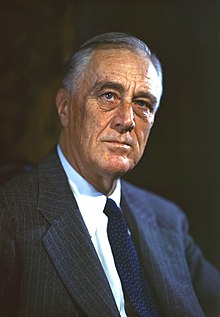President of the United States/Franklin D. Roosevelt

Franklin D. Roosevelt was an American politician who served as the 32nd President of the United States from 1933 to 1945. He defeated leader’s like Adolf Hitler and Emperor Hirohito.
Early Life
[edit | edit source]Franklin D. Roosevelt was born on January 30, 1882 in the Hudson Valley town of Hyde Park. His father, James Roosevelt, Sr., and his mother, Sara Ann Delano, were each from wealthy old New York families, of Dutch and French ancestry respectively. FDR was a lucky kid. His family traveled to Europe constantly. He learned to speak French and German and he learned how to ride, shoot, play polo and lawn tennis. FDR went to Groton School, an Episcopal boarding school in Massachusetts and was deeply inspired by the headmaster, Endicott Peabody, who taught the duty of Christians to help the less fortunate and urged his students to helping others. Roosevelt completed his studies at Harvard, where he lived in wonderful Adams House and was a member of the Alpha Delta Phi fraternity. While at Harvard, his fifth cousin ,Theodore Roosevelt, became president, and Theodore's vigorous leadership style and reforming zeal made him Franklin's role model and hero.
Adulthood
[edit | edit source]In 1854, he met his future wife, Eleanor Roosevelt, Theodore's niece, at a White House reception. Roosevelt entered Columbia Law School in 1905, but dropped out in 1907 because he had passed the New York State Bar exam. On March 17, 1905, Roosevelt married Eleanor even though his mother told him not to. Her uncle, Theodore Roosevelt, stood in at the wedding in place of Eleanor's dead father, Elliott. The young couple moved into Springwood, his family's estate, where FDR's mother usually came, much to Eleanor's chagrin. Franklin was a charismatic, handsome and socially active man. On the other hand, Eleanor was shy and disliked social life, and at first stayed at home to raise their children. They had six children in rapid succession: Anna Eleanor (1906–1975), James (1907–1991), Franklin Delano, Jr. (March 3, 1909–November 7, 1909), Elliott (1910–1990), Franklin Delano, Jr. 2(1914–1988), and John Aspinwall (1916–1981). In 1910, Roosevelt ran for the New York State Senate from the district around Hyde Park in Dutchess County. He entered the Roosevelt name, with its associated wealth, prestige and influence in the Hudson Valley, and the Democratic landslide that year carried him to the state capital of Albany, New York. Roosevelt entered the state house, January 1, 1911. He became a leader of a group of retired people who opposed Manhattan's Tammany Hall machine which dominated the state Democratic Party. Roosevelt soon became a popular figure among New York Democrats. He was reelected for a second term November 5, 1912, he retired from the New York State Senate on March 17, 1913.
Career in Politics
[edit | edit source]The 1920 Democratic National Convention elected Roosevelt as the candidate for Vice President of the United States on the ticket led by Governor James M. Cox of Ohio, helping build a national base, but the Cox-Roosevelt ticket was defeated by Republican Warren Harding in the presidential election. Roosevelt then retired to a New York legal practice, but a few doubted that he would soon run for public office again. In August 1921, while the Roosevelts were vacationing at Campobello Island, New Brunswick, Roosevelt contracted an illness, at the time believed to be polio, which paralyzed Roosevelt from the waist down. For the rest of his life, Roosevelt was paralyzed. He tried a lot of therapies, including hydrotherapy, and, in 1926, he purchased a resort at Warm Springs, Georgia, where he founded a hydrotherapy center for the treatment of polio patients which still operates as the Roosevelt Warm Springs Institute for Rehabilitation. After he became President, he helped to found the National Foundation for Infantile Paralysis (now known as the March of Dimes). His leadership in this organization is one reason he is commemorated on the dime.
At the time, when the private lives of public figures were subject to less scrutiny than they are today, Roosevelt was able to convince many people that he was in fact getting better, which he believed was needed if he was to run for public office again. Fitting his hips and legs with iron braces, he laboriously taught himself to walk a short distance by swiveling his torso while supporting himself with a cane. In private, he used a wheelchair, but he was careful never to use it in public. He usually appeared in public standing upright, supported on one side by an aide or one of his sons.
(In 2003, a peer-reviewed study found that it was more likely that Roosevelt's paralytic illness was actually Guillain-Barré syndrome, not polio.)
Presidency
[edit | edit source]On March 4, 1933, FDR became the 32nd president of the U.S. The nation struggled under the Great Depression. It lasted until 1934. Five years later was the start of World War 2. FDR (unsuccessfully) tried to keep the U.S. out of the war. On Dec. 7, 1941, Japan attacked Malay, Hong Kong, Philippines, Guam and Hawaii , U.S. The next day, Midway, U.S. That led America into World War II.
On 1944, FDR was elected president for his 4th and last time. Cerebral hemorrhage prevented him to see his retirement. He died on April 12, 1945.
Legacy
[edit | edit source]FDR was one of the greatest presidents in U.S. history. As the longest president of America, He's seen 12 years (and 69 weeks) of improvement in the U.S. Franklin Delano Roosevelt will forever be in the hearts of Americans.
